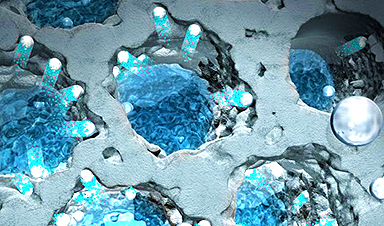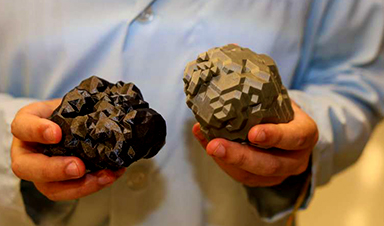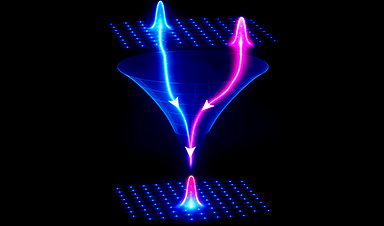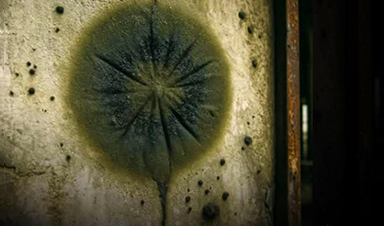A Hamburg-based research team has developed a new method for producing a network of large to very fine pores in silicon and glass. At DESY’s X-ray source PETRA III, scientists led by DESY researchers Stella Gries and Patrick Huber were able to analyse the porosity using X-ray tomography. The method for producing micro- and nanochannels, which the team is presenting in the journal Small (“Wafer-Scale Fabrication of Hierarchically Porous Silicon and Silica by Active Nanoparticle-Assisted Chemical Etching and Pseudomorphic Thermal Oxidation”), is easy to control, extremely variable and even works for large volumes of materials. This makes it ideal for use in industrial applications.
| In road networks, the method is common practice: while large motorways provide fast connections for long-distance traffic, small roads and lanes can be used to reach even the remotest corners of the country – albeit much more slowly. Nature often does the same thing, for example in the lungs or in plants: bronchial tubes or networks of large capillaries in leaves allow air or water to be transported rapidly across tissues, and then the channels branch out and become narrower until they reach the tiny alveoli or pores, where important local functions take place, such as supplying oxygen to the blood or carrying out photosynthesis. These highly efficient structures are known as hierarchical porous systems, and – being divided into large and small units – they can take care of extensive distribution or local functions. | |
| The research team led by DESY PhD student Gries is now able to produce silicon crystals with precisely such hierarchical porous systems. To achieve this, the scientists coated silicon wafers, which already had straight channels one micrometre in diameter passing through them, with silver nanoparticles. The 20 to 60 nanometre particles are deposited on the surface of the wafer. | |
| The scientists then exposed the wafers to a corrosive solution of hydrofluoric acid and hydrogen peroxide, triggering a fascinating and, at first glance, unbelievable process: the nanoparticles bore into the silicon, dissolving the silicon crystal at the surfaces where the silver particle was in contact with the silicon. | |
| Just as in the once popular computer game Pac-Man, the silver particles burrow further and further into the solid, leaving behind a fine network of tunnels along the way. The kinetic energy for the directed propulsion of the particles comes from a chemical decomposition reaction, i.e. the conversion of the hydrogen peroxide into water and hydrogen and the “eating up” of the silicon. | |
| The silver particles behave like small, autonomous Pac-Man agents, catalysing the reaction and thus enabling their own propulsion through the silicon crystal. The resulting system of tunnels self-organises to create the desired three-dimensional hierarchical porous structure. | |
| The research team used a number of different methods to investigate the porosity of the silicon. With the help of X-ray tomographic images taken at the PETRA III beamline P05, they were able to resolve the inner structure on a nanometre scale. “We see that the etching process systematically perforates the entire crystal, creating nanopores that are smaller than 100 nanometres,” says principal author Gries, who developed this method in Patrick Huber’s group in the course of her master’s thesis and is now conducting further research as part of her doctorate. | |
| “By adjusting the size of the nanoparticles and the duration of the procedure, we can precisely control how deep the hierarchical porous system extends,” adds Manuel Brinker, a member of the group that helped supervise Stella Gries’s research. | |
| Longer exposures produce pores that penetrate to the parallel main channels in the silicon wafer, connecting them with each other. For the time being, the exact mechanisms that lead to the movement of the particles, and thus to the formation of the network of channels, are only partially understood. Sometimes, for example, the particles travel along spiral paths, leading to spiral-shaped nanochannels in the silicon, and sometimes they change direction abruptly, suggesting that the particles are rotating. The network of pores produced has a sponge-like structure and thus no preferred orientation, unlike the large main channels. | |
| “We suspect that the geometric shape of the silver nanoparticles has a strong influence on the way the particles eat into the silicon,” says Gries. |
| In a further step, the scientists heated the perforated silicon to over 800 degrees Celsius in an atmosphere containing oxygen. The walls between the tunnels are so thin that the silicon was completely oxidised to form silicon dioxide, colloquially known as glass. | |
| To the scientists’ great surprise, the structure of channels was not destroyed despite the considerable rearrangement of the atoms and the expansion of the walls when the oxygen was incorporated. This means that the open-pored structure allows the wafers to be transformed into hierarchical porous glass. | |
| The team was able to make this material, which has a milky appearance due to the way its pores reflect white light, transparent by infiltrating it with water. This means the amount of light absorbed by the glass can be very easily controlled by moistening and drying the material, an effect that could be used, for example, for simple functions in windows, which could be switched by the humidity in the air. Such smart glasses could be switched comparatively quickly because wetting and drying can take place quickly throughout the entire volume thanks to the multiscale transportation routes. | |
| Overall, the scientists anticipate a wide range of potential applications, including in energy technology. “Silicon still has the highest potential to serve as an electrode material for lithium-ion batteries,” says Patrick Huber (DESY and TU Hamburg). “Our new etching technique may form the basis for a new generation of battery cells with a high charge density and a large number of charging cycles, if it turns out that not only vitrification, i.e. the incorporation of oxygen, but also the incorporation of lithium preserves the internal structure thanks to the hierarchical porosity of the silicon crystals. In non-porous silicon, this lithiation usually destroys the material.” | |
| The next step will be to gain an even better understanding of how the manufacturing parameters affect porosity and what exactly drives forward the silver particles as they are perforating the material. Stella Gries intends to look into this in her doctorate. In a next step, we will also be investigating the lithiation of the hierarchical porous silicon in cooperation with other partners. | |
| The procedure, for which the researchers have applied for a patent, was developed within the framework of the Centre for Integrated Multiscale Materials Systems, CIMMS, and the Collaborative Research Centre “SFB 986: Tailor-Made Multiscale Materials Systems”, which is based at the Hamburg University of Technology. |
News
Researchers propose five key questions for effective adoption of AI in clinical practice
While Artificial Intelligence (AI) can be a powerful tool that physicians can use to help diagnose their patients and has great potential to improve accuracy, efficiency and patient safety, it has its drawbacks. It [...]
Advancements and clinical translation of intelligent nanodrugs for breast cancer treatment
A comprehensive review in "Biofunct. Mater." meticulously details the most recent advancements and clinical translation of intelligent nanodrugs for breast cancer treatment. This paper presents an exhaustive overview of subtype-specific nanostrategies, the clinical benefits [...]
It’s Not “All in Your Head”: Scientists Develop Revolutionary Blood Test for Chronic Fatigue Syndrome
A 96% accurate blood test for ME/CFS could transform diagnosis and pave the way for future long COVID detection. Researchers from the University of East Anglia and Oxford Biodynamics have created a highly accurate [...]
How Far Can the Body Go? Scientists Find the Ultimate Limit of Human Endurance
Even the most elite endurance athletes can’t outrun biology. A new study finds that humans hit a metabolic ceiling at about 2.5 times their resting energy burn. When ultra-runners take on races that last [...]
World’s Rivers “Overdosing” on Human Antibiotics, Study Finds
Researchers estimate that approximately 8,500 tons of antibiotics enter river systems each year after passing through the human body and wastewater treatment processes. Rivers spanning millions of kilometers across the globe are contaminated with [...]
Yale Scientists Solve a Century-Old Brain Wave Mystery
Yale scientists traced gamma brain waves to thalamus-cortex interactions. The discovery could reveal how brain rhythms shape perception and disease. For more than a century, scientists have observed rhythmic waves of synchronized neuronal activity [...]
Can introducing peanuts early prevent allergies? Real-world data confirms it helps
New evidence from a large U.S. primary care network shows that early peanut introduction, endorsed in 2015 and 2017 guidelines, was followed by a marked decline in clinician-diagnosed peanut and overall food allergies among [...]
Nanoparticle blueprints reveal path to smarter medicines
Lipid nanoparticles (LNPs) are the delivery vehicles of modern medicine, carrying cancer drugs, gene therapies and vaccines into cells. Until recently, many scientists assumed that all LNPs followed more or less the same blueprint, [...]
How nanomedicine and AI are teaming up to tackle neurodegenerative diseases
When I first realized the scale of the challenge posed by neurodegenerative diseases, such as Alzheimer's, Parkinson's disease and amyotrophic lateral sclerosis (ALS), I felt simultaneously humbled and motivated. These disorders are not caused [...]
Self-Organizing Light Could Transform Computing and Communications
USC engineers have demonstrated a new kind of optical device that lets light organize its own route using the principles of thermodynamics. Instead of relying on switches or digital control, the light finds its own [...]
Groundbreaking New Way of Measuring Blood Pressure Could Save Thousands of Lives
A new method that improves the accuracy of interpreting blood pressure measurements taken at the ankle could be vital for individuals who are unable to have their blood pressure measured on the arm. A newly developed [...]
Scientist tackles key roadblock for AI in drug discovery
The drug development pipeline is a costly and lengthy process. Identifying high-quality "hit" compounds—those with high potency, selectivity, and favorable metabolic properties—at the earliest stages is important for reducing cost and accelerating the path [...]
Nanoplastics with environmental coatings can sneak past the skin’s defenses
Plastic is ubiquitous in the modern world, and it's notorious for taking a long time to completely break down in the environment - if it ever does. But even without breaking down completely, plastic [...]
Chernobyl scientists discover black fungus feeding on deadly radiation
It looks pretty sinister, but it might actually be incredibly helpful When reactor number four in Chernobyl exploded, it triggered the worst nuclear disaster in history, one which the surrounding area still has not [...]
Long COVID Is Taking A Silent Toll On Mental Health, Here’s What Experts Say
Months after recovering from COVID-19, many people continue to feel unwell. They speak of exhaustion that doesn’t fade, difficulty breathing, or an unsettling mental haze. What’s becoming increasingly clear is that recovery from the [...]
Study Delivers Cancer Drugs Directly to the Tumor Nucleus
A new peptide-based nanotube treatment sneaks chemo into drug-resistant cancer cells, providing a unique workaround to one of oncology’s toughest hurdles. CiQUS researchers have developed a novel molecular strategy that allows a chemotherapy drug to [...]





















